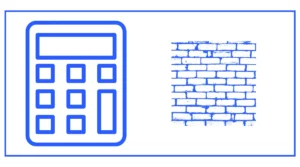Rebar Calculator
Grid Length: 0 m
Grid Width: 0 m
Total Rebars Length: 0 m
# of Rebar Pieces: 0
Total Cost of Rebars: 0 $
This rebar calculator helps you calculate the number of required rebar pieces, their length, cost, grid length, and grid width.
Enter the length and width in meters, rebar-rebar spacing (cm), edge-grid spacing (cm), wire price ($/m), length of single rebar (m), and price of single rebar ($).
Rebar, which stands for “reinforcing bar” or “reinforcement bar,” is a metal bar used to increase the tensile strength of concrete. As a result, it helps concrete constructions resist tensile, bending, torsion, and shear loads.

You might want to calculate the required stud or pool expenditures.
Understanding Rebar and Its Importance
Rebar is a steel bar or mesh of steel wires used as a tension device in reinforced concrete and reinforced masonry structures. Concrete is strong in compression but relatively weak in tension. The addition of rebar significantly increases the tensile strength of the structure.
Some key points about rebar:
- It’s typically made from carbon steel and is formed with ridges for better adherence to concrete.
- Rebar comes in various sizes, usually measured by its diameter.
- The spacing of rebar in a concrete structure is crucial for its effectiveness.
What is a Rebar Calculator?
A rebar calculator is a tool designed to help contractors, engineers, and DIY enthusiasts estimate the amount of rebar needed for a specific project. This calculator takes into account various factors such as:
- The dimensions of the concrete structure
- The spacing between rebar pieces
- The size (diameter) of the rebar
- The length of individual rebar pieces
By inputting these parameters, the calculator can provide an estimate of:
- The total length of rebar needed
- The number of individual rebar pieces required
- The total weight of the rebar (useful for transportation and cost estimation)
How to Use a Rebar Calculator
Using a rebar calculator is typically straightforward. Here’s a step-by-step guide:
- Measure the dimensions of your concrete structure (length, width, and sometimes depth).
- Determine the spacing you want between rebar pieces (this often depends on local building codes).
- Choose the size (diameter) of rebar you’ll be using.
- Input these values into the calculator.
- Review the results, which usually include the total length of rebar needed and the number of individual pieces.
Let’s look at an example:
Suppose you’re building a concrete slab for a driveway. The slab measures 20 feet long by 15 feet wide. You’ve decided to use #4 rebar (1/2 inch diameter) with 12-inch spacing.
Using a rebar calculator, you would input:
- Length: 20 feet
- Width: 15 feet
- Spacing: 12 inches
- Rebar size: #4 (1/2 inch)
The calculator might then tell you that you need approximately 350 linear feet of rebar, which could translate to about 18 pieces of 20-foot rebar.
Benefits of Using a Rebar Calculator
- Accuracy: Rebar calculators reduce the chance of human error in calculations.
- Time-saving: They provide quick results, saving you from manual calculations.
- Cost-effective: By providing precise estimates, they help prevent over-ordering or under-ordering of materials.
- Project planning: Accurate material estimates help in better project planning and scheduling.
Limitations of Rebar Calculators
While rebar calculators are incredibly useful, it’s important to understand their limitations:
- They provide estimates, not exact figures. Always allow for some margin in your orders.
- They don’t account for unique structural requirements. Complex projects should always involve a structural engineer.
- Building codes and best practices can vary by location. Always verify calculations against local regulations.
Example: Calculating Rebar for a Concrete Foundation
Let’s walk through a more complex example to illustrate the use of a rebar calculator in a real-world scenario.
Imagine you’re planning to build a house and need to calculate the rebar for the concrete foundation. The foundation will be a rectangular slab measuring 40 feet long by 30 feet wide. You plan to use #5 rebar (5/8 inch diameter) with 18-inch spacing in both directions.
Using a rebar calculator, you would input:
- Length: 40 feet
- Width: 30 feet
- Spacing: 18 inches
- Rebar size: #5 (5/8 inch)
The calculator might provide the following results:
- Total length of rebar needed: approximately 840 linear feet
- Number of 20-foot rebar pieces: 42
- Estimated weight: about 1,050 pounds (assuming 1.25 pounds per linear foot for #5 rebar)
This information allows you to order materials accurately and plan for transportation and placement of the rebar.
Rebar Calculator: A Valuable Tool for Various Projects
Rebar calculators aren’t just for large construction projects. They can be valuable for a wide range of applications:
- Residential projects: Driveways, patios, home additions
- Commercial construction: Office buildings, warehouses, parking structures
- Infrastructure projects: Bridges, roads, tunnels
- Agricultural applications: Barn foundations, silos
- DIY projects: Concrete countertops, outdoor pizza ovens
Tips for Effective Use of Rebar Calculators
To get the most out of your rebar calculator:
- Double-check your measurements before inputting them.
- Understand the rebar sizes and their applications.
- Be aware of local building codes regarding rebar spacing and size.
- Always add a small percentage (5-10%) to your calculated amount to account for waste and overlaps.
- Consider using the calculator in conjunction with a sketch or diagram of your project for better visualization.
References
- Cantone, R., Ruiz, M. F., & Muttoni, A. (2021). A detailed view on the rebar–to–concrete interaction based on refined measurement techniques. Engineering Structures, 226, 111332.
- Ahmed, K. S., Shahjalal, M., Siddique, T. A., & Keng, A. K. (2021). Bond strength of post-installed high strength deformed rebar in concrete. Case Studies in Construction Materials, 15, e00581.





